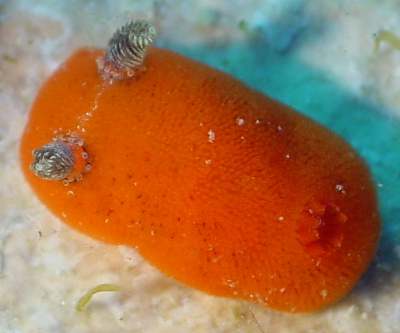
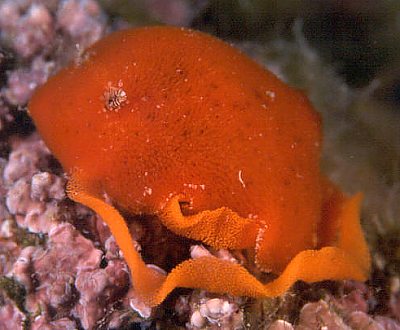
Rostanga rubra
(Risso, 1818)
Order: NUDIBRANCHIA
Suborder: DORIDINA
Superfamily: EUDORIDOIDEA
Family: Dorididae
DISTRIBUTION
Recorded from the Atlantic coast of Europe and North Africa, and from the Mediterranean.
PHOTO
Upper: Cerbere, France, Mediterranean coast, July 11, 2003. Size: 8-10mm. Photo: Marina Poddubetskaia
Lower: 15/05/2002
Place: Kemer, Turkey, 15 May 2002, Depth: 15m, Size: 6-7cm. Photo: Levent Konuk
Thompson & Brown, (1984) and Schmekel & Portmann (1982) considered Rostanga coccinea and R. perspicillata to be synonymous with R. rubra (Risso), and R. rufescens to be an unnecessary replacement name for R. coccinea. Not mentioned in these reviews is R. temarana Pruvot-Fol, 1953, described from the Atlantic coast of Morocco which shows no difference in radular morphology from R. rubra and at 3-4 mm long, is almost certainly based on juveniles.
Rostanga rubra is red with vertically arranged rhinophore lamellae. The bifid outer lateral teeth are similar to those of the Indo-West Pacific species R. bifurcata, from which it differs in rhinophore shape and shape of inner lateral teeth. The inner lateral teeth of R. rubra have been described as bicuspid by many authors because of a prominent pointed projection on the outside of the main cusp. This secondary 'cusp' is derived from the angular shoulder present on the inner lateral teeth of many species of Rostanga.
The egg-ribbon has been described as white (Alder & Hancock, 1848) and 'rose-coloured' (Kress, 1971). Kress has carefully observed and measured all stages in development from single-celled egg to hatching Type 1, planktotrophic veliger in 12 days (15-18°C). The egg ribbon of almost two whorls is a stiff jelly-like structure similar to that of Rostanga arbutus but the eggs are much smaller.
Because of the well-known problems concerning sponge taxonomy and misidentifications, food records for this species must be treated with some caution. Kress (1971) records it from Microciona atrosanguinea and rarely from Hymeniacidon sanguinea while Thompson & Brown (1984) state that it "feeds upon red siliceous sponges such as Microciona sanguinea Bowerbank". Brown & Picton (1979) note that it "feeds on sponges (e.g. Ophlitaspongia seriata)".
References:
• Rudman, W.B. & Avern, G.J. (1989) The genus Rostanga Bergh, 1879 (Nudibranchia:
Dorididae) in the Indo-West Pacific. Zoological Journal of the Linnean Society, 96: 281-338.
• Schmekel, R. L., & Portmann, A. (1982) Opisthobranchia des Mittelmeeres, Nudibranchia und Saccoglossa. Fauna e flora del Golfo di Napoli 40, Monografia della Stazione Zoologica di Napoli, pp. i-viii, 1-410, pls. 1-36. Springer-Verlag.
• Thompson, T. E. & Brown, G.H. (1984) Biology of opisthobranch molluscs, vol. 2, 229 pp., 41 pls. Ray Society, no. 156.
Rudman, W.B., 2002 (February 17) Rostanga rubra (Risso, 1818). [In] Sea Slug Forum. Australian Museum, Sydney. Available from http://www.seaslugforum.net/find/rostrubr
Related messages
Rostanga rubra from Turkey
June 2, 2010
From: Hakan Kabasakal
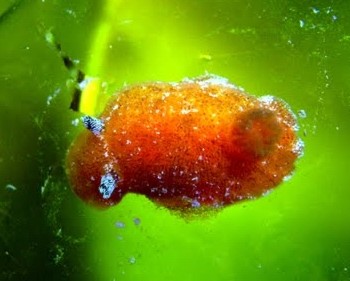
Dear Bill,
I shot this photograph of Rostanga rubra (Risso, 1818) in the northeastern Sea of Marmara, a fragile ecosystem under heavy anthropogenic impacts for the last 50 years. Although it is associated with sponges Microciona spp. or Halichondria spp., this specimen was seen browsing on green algae, Ulva spp.
Locality: Dar?ca, 6 metres, Turkey, Sea of Marmara, 9 May 2010, Sea weed. Length: ca. 20 mm. Photographer: Hakan Kabasakal.
Best regards,
Hakan Kabasakal
hakankabasakal@superposta.com
Kabasakal, H., 2010 (Jun 2) Rostanga rubra from Turkey. [Message in] Sea Slug Forum. Australian Museum, Sydney. Available from http://www.seaslugforum.net/find/23669Dear Hakan,
Species of Rostanga are very specific sponge feeders so although your animal was crawling over green algae I can be pretty sure that it was not eating it. Many years ago I used to wonder why I often found the common intertidal species of Rostanga in Sydney, R. arbutus, crawling over brown algae in rock pools apparently browsing. I later discovered that the red sponge it feeds on, the microcionid Clathria aceratoobtusa, lives hidden in crevices in the sandstone rock, so we could never actually see it feeding.
Best wishes,
Bill Rudman
Rostanga rubra from Devon, UK
August 13, 2005
From: Judith Oakley
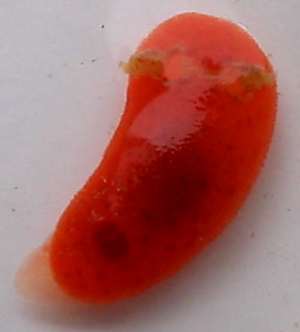
Here is Rostanga rubra found on Fucus serratus in Torbay, Devon, UK.
Locality: Goodrington Sands, Torbay, Devon, UK. Length: 7 mm. 4 July 2005. intertidal on F serratus. Photographer: Judith Oakley
Judith Oakley
kf1@mba.ac.uk
Oakley, J.A., 2005 (Aug 13) Rostanga rubra from Devon, UK. [Message in] Sea Slug Forum. Australian Museum, Sydney. Available from http://www.seaslugforum.net/find/14438Thanks Judith,
Even half out of water I would agree with your identification. In fact the half-wet look shows the bristly spiculate tubercles [caryophyllidia] which cover its mantle very well.
Best wishes,
Bill Rudman
Rostanga rubra from Slovenia
June 13, 2005
From: Tom Turk
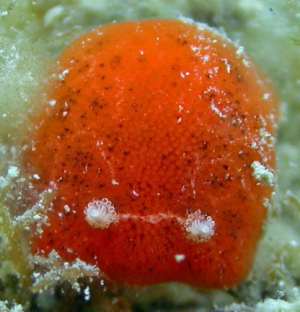
Dear Bill,
Here is a nudibranch from the Slovenian coast. I have tentatively identified it as a Rostanga or Thordisa, but I need some additional help. It was taken in shallow infralitoral zone.
Locality: Piran, Slovenia, Adriatic Sea. Spring 2005. muddy, phytal. Photographer: Tihomir Makovec
Cheers,
Tom Turk
tom.turk@bf.uni-lj.si
Turk, T., 2005 (Jun 13) Rostanga rubra from Slovenia. [Message in] Sea Slug Forum. Australian Museum, Sydney. Available from http://www.seaslugforum.net/find/13927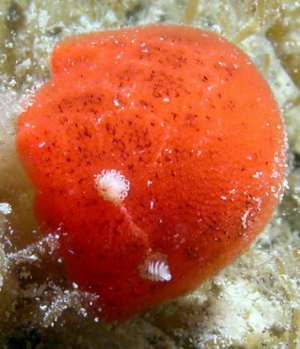
Dear Tom,
I guess this is Rostanga rubra. The whitish line between the rhinophore pockets seems to be a characteristic feature of this species.
Best wishes,
Bill Rudman
Rostanga rubra from Scotland
August 6, 2004
From: Jim Anderson
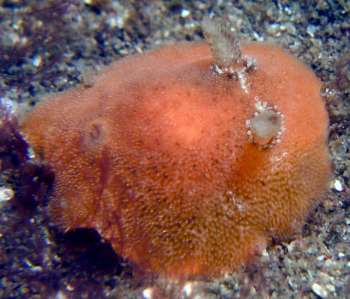
Dear Bill,
Attached is a recent image of Rostanga rubra the above.
Data: Ross Carr, Eyemouth [southeast coast], Scotland. 1 August, 2004. Water temperature 14°C. This 10mm long animal was found on the reef at 14 metres on the ebb tide. Photo: Jim Anderson.
['carr' is a local word for these underwater rocky reefs that do not break the surface]
Jim Anderson
Scottish Nudibranchs
jander4454@blueyonder.co.uk
Anderson, J., 2004 (Aug 6) Rostanga rubra from Scotland. [Message in] Sea Slug Forum. Australian Museum, Sydney. Available from http://www.seaslugforum.net/find/12732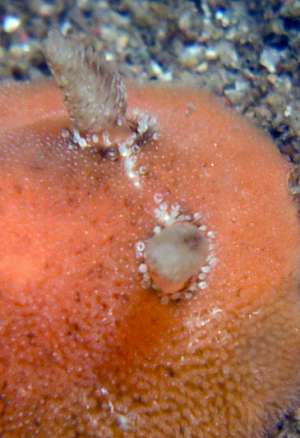
Thanks Jim,
The white line between the two rhinophore pockets seems to be a chracteristic of this species. It makes me wonder if the animal Michel Barrabés photos in Erwin Koehler's message [#6270] is the same species. Perhaps there is a faint trace of the white line, I am not sure
Best wishes
Bill Rudman
Rostanga rubra - eggs ?
July 28, 2003
From: Jean-Pierre Bielecki
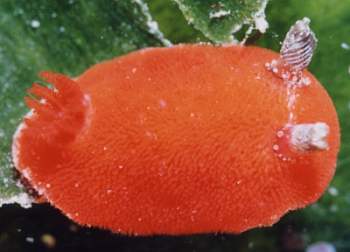
Hi Bill
Here is one other shot of the same slug that Marina Poddubetskaia sent you in her previous message.
The slug is exactly in the position when I found it, that is to say into this piece of broken shell (Pinna nobilis). When I saw it I was too excited to see the eggs near it. Do you think these eggs could belongs to this animal or it is a real stroke of luck?
Best wishes
Jean-Pierre
bielecki.jeanpierre@free.fr
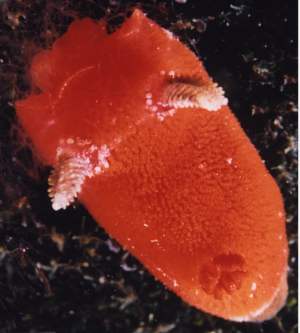
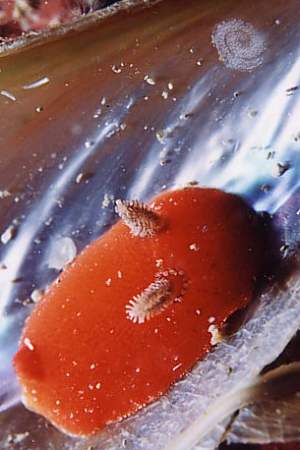
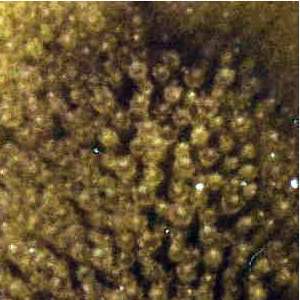
Dear Jean-Pierre,
The egg ribbon is just a co-incidence. As far as I know all species of Rostanga produce orange or orange-red eggs possibly incorporating pigment from their sponge food. Have a look at Baki Yoke's message for photos of this species' egg ribbon. I can't say much about the white egg mass in your photo. It may be an opisthobranch but could be a snail of some sort.
I have included alongside a closeup of part of your lower left photo. With a bit of digital magic I was able to enhance the detail of the mantle to show what the caryophyllidia or 'bristles' on this species look like. The bristles, or tubercles, which give the mantle its furry appearance, are elongate structures with a central terminal rounded knob, and below it a ring of upwardly directed pointed spicules.
Best wishes,
Bill Rudman
Rostanga rubra from French Mediterranean
July 21, 2003
From: Marina Poddubetskaia

Dear Bill,
Here is Rostanga rubra from Cerbere. This animal was kindly identified by Lucas Cervera.
Date: July 11, 2003
Location: Cerbere, France, Mediterranean coast
Site: Les Chambres
Size: 8-10mm
Photos: Marina Poddubetskaia - Nembro website
Cordially,
Marina.
nembro@nembro.info
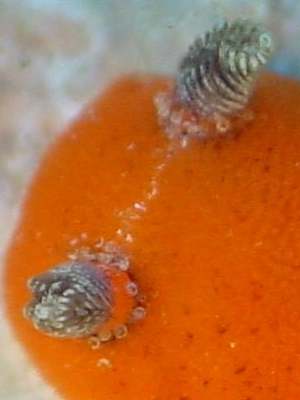
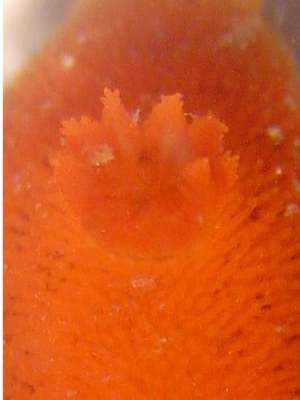
Thanks Marina,
Its good to get some photos showing the gills and rhinophores clearly,
Best wishes,
Bill Rudman
Rostanga sp. from Turkey
May 27, 2002
From: Baki Yokes

Dear Bill,
These photos were taken in Kemer, Turkey by Levent Konuk. The spiculate structure of the mantle suggests a Rostanga sp., but which one? As far as I know there is only Rostanga rubra in the Mediterranean. But the animals seen in Michel Barrabés' photos look more flat than this one. And also the presence of the characteristic white or yellowish patch that lies between the rhinophores in Rostanga rubra, is not so clear in this specimen. What is your opinion?
Photographic data:
Date: 15/05/2002
Place: Kemer, Turkey
Divesite: Tünel
Depths: 15m
Size: 6-7cm
Photos: Levent Konuk [leventkonuk@turk.net]
Best wishes
Baki
bakiyokes@turk.net
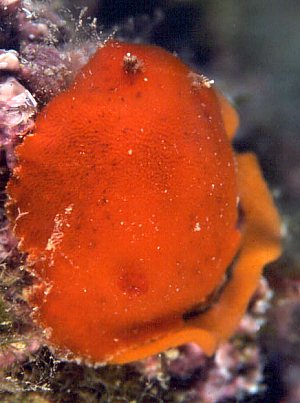
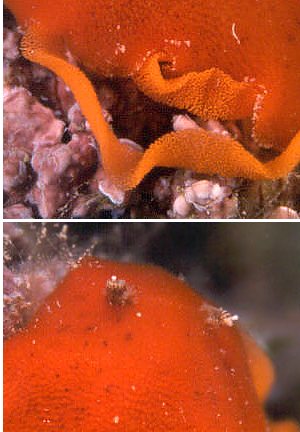
Dear Baki,
Thanks for this nice photo showing egg-laying. From my reading of the literature there are only two species at present accepted from the Mediterranean, R. rubra and Rostanga anthelia. R. anthelia sems to be known only from very small, possibly juvenile specimens, so it is not clear wheher the described colour pattern with many large white patches a round the edge is a juvenile feature or will also be found in adults.
R. rubra is ceratinly a possibility. If you look carefully between the rhinophores in your photos there is a trace of white. The shape of the egg ribbon, and the size of the eggs is similar to that described for R. rubra but the colour is not. Its eggs have been described as white or pale pink but never bright orange. As to the flattened appearance of animals in Michel Barrabés' photos. It is quite usual in Rostanga to find animals becoming very flattened when they are on their food sponge but quite raised when crawling on other substrates.
The only sure way to find out what you have would be to look at the anatomy - I still have difficulty identifying specimens of species I am reasonably familiar with. I look forward to comments from peoplemore familiar with European species of this genus. I will temporarily put your message on the R. rubra page more more administrative convenience than beacause I am convinced it is that species
Best wishes,
Bill Rudman
Rostanga rubra from Mediterranean
February 19, 2002
From: Erwin Köhler
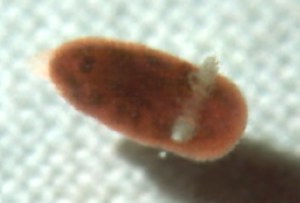
Dear Bill,
attached is a shot of Rostanga rubra by Antonio S. Perrone.
Data: size unrecorded, depth 2m, Italy, Taviano, divesite: "Mancaversa", 05 Sept. 1983
Cheers,
Erwin
Erwin@medslugs.de
Köhler, E., 2002 (Feb 19) Rostanga rubra from Mediterranean. [Message in] Sea Slug Forum. Australian Museum, Sydney. Available from http://www.seaslugforum.net/find/6269Thanks Eriwn,
Bill Rudman
Rostanga rubra from W-France
February 19, 2002
From: Erwin Köhler
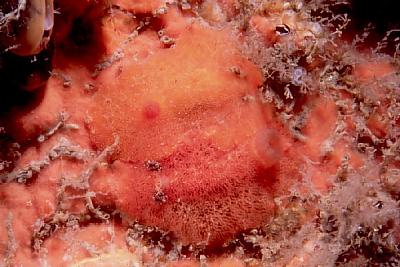
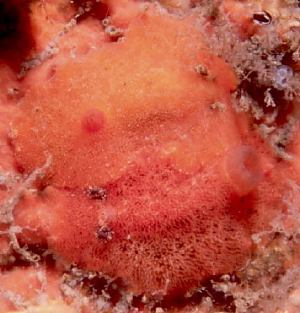
Dear Bill,
Attached is a shot of Rostanga rubra by Michel Barrabés
Email: m.barrabes@libertysurf.fr
Data: size ~20mm, depth unrecorded, France, Bassin d'Arcachon,[west coast of France] divesite: "Hortense", 05 June 1999
Cheers,
Erwin
Erwin@medslugs.de
Köhler, E., 2002 (Feb 19) Rostanga rubra from W-France. [Message in] Sea Slug Forum. Australian Museum, Sydney. Available from http://www.seaslugforum.net/find/6270Dear Erwin & Michel,
Thanks for the photo. I know I shouldn't be surprised, but species of Rostanga are definitely very good at looking like their food sponge.
Best wishes,
Bill Rudman
